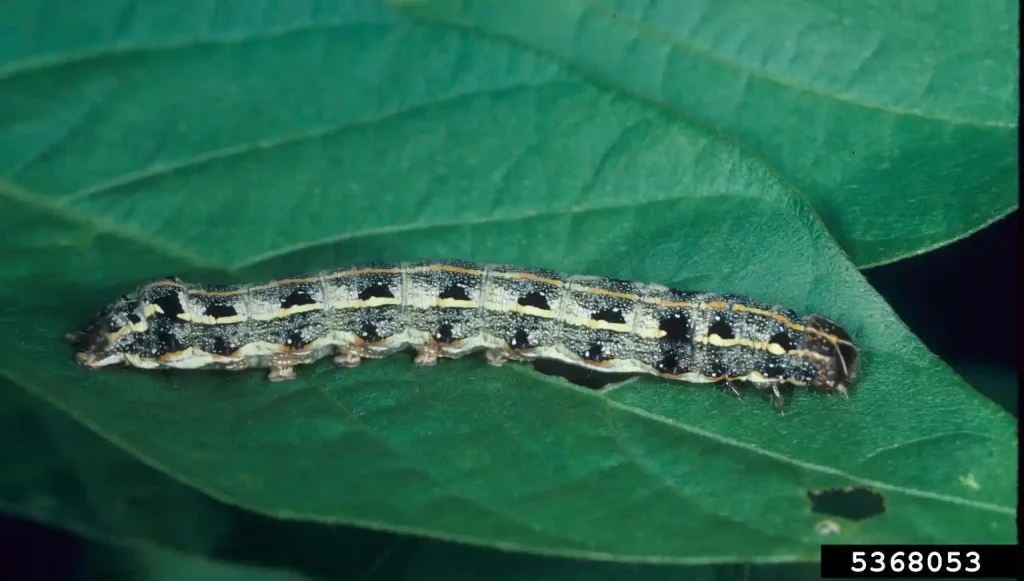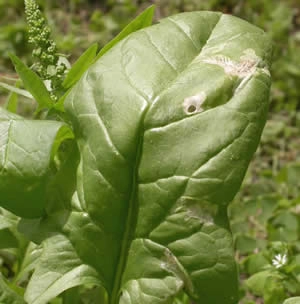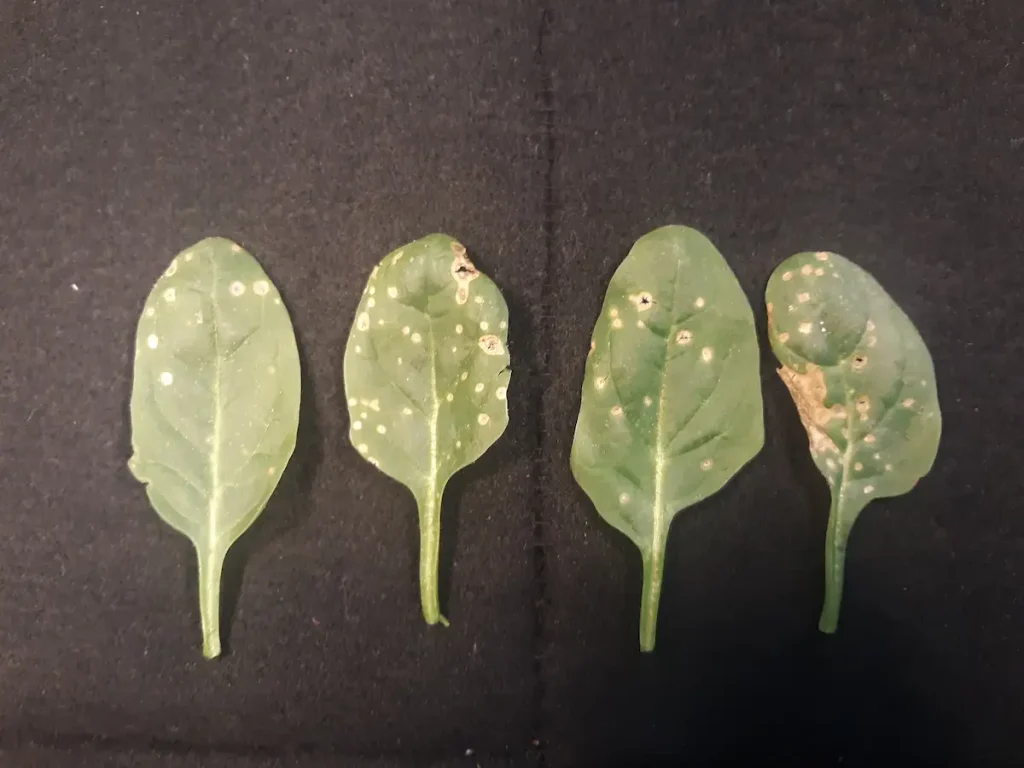Easy to grow and quick to harvest, spinach is one of the vegetables widely cultivated by farmers. Simply by making beds and sowing seeds, farmers can harvest spinach in just 1.5 months.
This abundant vegetable is widely consumed by the public because it is rich in nutrients and has various benefits. This iron source vegetable is useful for increasing hemoglobin levels and preventing anemia.
However, this delicious nutritious vegetable is also favored by pests. Pests and diseases are a complex challenge in producing quality spinach.
Pests That Often Attack Spinach Plants
Pests that attack spinach include caterpillars, aphids, mites, and snails. These pests cause spinach to have holes, curl, have scratches or spots so that it looks unattractive.
1. Leaf Caterpillars or Tritip

The caterpillar with the Latin name Plutella xylostella attacks many vegetables by eating young leaves and attacking the growing points. In severe attacks, these small green caterpillars can eat almost the entire surface of the leaf, leaving only the leaf veins.
2. Armyworm

Armyworms not only attack spinach but can also eat various types of plants. When they are still small, these caterpillars gather under the surface of the leaves and leave the upper epidermis layer so that the leaves become thin. When they are large, these caterpillars cause holes in spinach leaves and even leave nothing behind.
3. Aphids

Aphids attack by sucking the cell fluid in the leaves so that the leaves become wrinkled, curly, and dry. These small insects attack many plants during the dry season. Aphids usually gather under the surface of the leaves, between the leaves, and at the growing points of the plant.
4. Earthworm

Earthworms attack young spinach plants by eating the roots so that the spinach plants cannot grow. This caterpillar attacks at night and loose soil is very favored by this caterpillar.
5. Grasshopper
These insects feed on spinach and leave marks on the edges of the leaves. These green to brown insects jump to move to other areas. Therefore, planting spinach in open areas is susceptible to grasshopper attacks.
6. Leaf Miner Fly

The female leafminer fly injects its ovipositor to insert eggs and leaves white spots on the leaf surface. The eggs hatch into larvae which then eat the leaf tissue and produce tunnels that look like white or gray lines from the outside. Spinach leaves that have these lines are not liked by consumers so the spinach becomes unfit for sale.
7. Snail
Snails can eat spinach seedlings that have just grown in beds. This pest also attacks by eating spinach leaves, stems, and roots so that they become holes and leave mucus.
These Are Signs That Your Spinach Is Sick

Spinach that has spots indicates a disease that is usually caused by fungus. High humidity can increase the development of pathogens that cause disease so that it can easily spread to other spinach plants.
Recognizing the characteristics of spinach that is infected with disease can help us take preventive measures so that the cause of the disease does not spread throughout the beds.
1. Downy mildew disease
Downey mildew or downy mildew disease is caused by a fungus, namely Peronospora farinosa f. sp. Spinaciae. In spinach plants affected by downy mildew disease, there are yellow or light green spots on the upper surface of the leaves with white fungus on the lower surface. These spots then develop into enlarged, brownish and dry spots so that the leaves look rotten.
2. Anthracnose
Spinach plants affected by anthracnose initially have damaged tissue or small, circular, and watery lesions. Then the lesions develop into brownish and become thin like paper. This disease is caused by the fungus Colletotrichum Pinaceae.
3. Cladosporium leaf spot
This leaf spot is caused by the fungus Cladosporium variabile. Spinach plants affected by this disease have round brownish spots then in the middle develop spores and dark green mycelium.
4. Stemphylium leaf spot
This leaf spot is caused by the fungus Stemphylium. Initially, spinach plants affected by this disease have small circular to oval spots that are greenish-gray in color. Then the spots enlarge and turn brownish in color. Older spots merge, dry out, and become papery.
Easy Ways to Overcome Pests and Diseases in Spinach Plants

Pests and diseases can damage spinach plants, reducing their quality. Leaves with holes, wilted, spotted, or spots will not be liked by consumers.
Severe attacks can even cause crop failure, causing losses for farmers. Therefore, it is important for us to understand how to recognize, prevent, and overcome these problems as early as possible.
The following steps can help us reduce pest and disease attacks to produce abundant and quality spinach crops.
1. Using superior varieties of spinach seeds
Spinach seeds have been developed to have superior characteristics such as having wide leaves to be preferred by consumers, fast harvesting, able to adapt to various land conditions, high production results, and resistant to pests and diseases. For example, spinach that is resistant to powdery mildew or blorok on leaves is green Maestro spinach and red Mira spinach.
There is also Tainung spinach that is resistant to white rust disease. By using superior varieties, we can increase the resistance of spinach plants to pests and diseases naturally.
2. Technical culture: Land sanitation and crop rotation
Land sanitation is cleaning the land from things that can be a source of spreading pests and diseases. Weeds and crop residues after harvest can be a hiding place for pests and a breeding ground for diseases. Cleaning the land from weeds and crop residues can help break their cycle.
Pest and disease cycles can also be broken by crop rotation, which is replacing the type of plant planted with another family. After harvesting spinach, we need to plant other types of plants such as beans or tubers that are different families from spinach.
Excessively humid environmental conditions can accelerate the growth of disease-causing pathogens. The rainy season can cause puddles that can increase air humidity. With good soil cultivation, we can produce beds with good drainage so that puddles can be prevented.
We can also improve soil aeration so that rainwater can be absorbed into the soil. Perfect soil cultivation can also damage pupae that were originally hidden in the soil to be carried up so that they are exposed to direct sunlight.
3. Perform mechanical control
Mechanical control is done by taking pests and destroying them. In addition, we can take groups of eggs attached to the leaves so that they do not hatch into larvae that can damage spinach plants. Parts of the leaves that have symptoms of disease also need to be removed by being pulled out and destroyed so that the pathogens that cause the disease do not spread to other plants.
4. Carry out biological control
One of the factors that control S. litura in nature is natural enemies. Natural enemies that attack S. litura consist of three groups, namely predators, parasitoids, and pathogens. Natural enemies of armyworms consist of;
(1) predators such as caterpillar-eating birds, spiders of the species Oxyopes javanus Thorell and Lycosa pseudoannulata, tomcats Paederus fuscipes and red ants Solenopsis geminata.
(2) Parasitoids such as Snellenius manilae Ashmed, Megoselia scalaris Loew and Peribaea orbata Wied.
(3) Insect pathogens such as Borrelinavirus litura, Bacillus thuringiensis Berliner, Metharizium anisopliae and Nuclear Ployhidrosis Virus (NPV).
The existence of predators such as caterpillar-eating birds must of course be preserved because they effectively control the population of caterpillar pests in general. The existence of predators and parasitoids will also be more sustainable with the wise use of pesticides.
Meanwhile, for insect pathogens, many are already selling them in the form of biological pesticide products containing insect pathogens such as Borrelinavirus litura, Bacillus thuringiensis Berliner and Metharizium anisopliae.
5. Spraying herbal pesticides
Botanical pesticides are plant medicines that use extracts of natural ingredients such as neem leaf or seed extract, noni fruit, tobacco leaves, soursop leaves, papaya leaves, citronella extract, and others. Spraying botanical pesticides needs to be done routinely to avoid pests and diseases in spinach.
6. Spraying chemical pesticides
Synthetic chemical pesticides are the last alternative when all control techniques are unable to suppress the pest population. The types of active ingredients recommended are chlorpyrifos, cypermethrin, betacyfluthrin, lambdacyhalothrin, fluxametamide, emamectin benzoate and profenofos.




